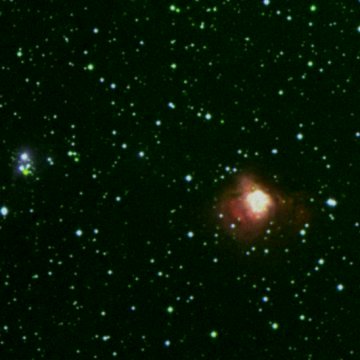Sh 2-156
Also called
IC 1470Coordinates: (110.1°, 0.0°)
[ Catalog | Explorer | SIMBAD ]
The bright core is only one of five distinct and apparently independent emission sources within a giant molecular cloud.
Avedisova places Sh 2-156 in star formation region 110.12+0.04 with 35 components, including 7 masers, the reflection nebulae [SS62] 71 and PP 104 and the HII regions BFS 15 and BFS 16.
Russeil expands this star formation region and adds the HII regions BFS 14, BFS 17 and BFS 18 as well.
The bright core is only one of five distinct and apparently independent emission sources within a giant molecular cloud. [2]
Also called IC 1470, this is an HII region that appears to be ionised by a single O7 class star. The distance is estimated to be about 3500 to 4000 parsecs.[3]
Russeil star formation analysis. [4]
Contains the infrared star cluster [BDS2003] 42. [5]
Notes
1. ^ Avedisova, V. S. & Kondratenko, G. I. (1984). "Exciting stars and the distances of the diffuse nebulae", Nauchnye Informatsii, Vol. 56, 59. [1984NInfo..56...59A]
2. ^ Joy, M., Harvey, P. M., Evans, N. J., II, et al. (1984). "Infrared and millimeter-wave observations of the Sharpless 156 molecular cloud", The Astrophysical Journal, Vol. 284, 161-175. [1984ApJ...284..161J]
3. ^ Lynds, B. T. & Oneil, E. J., Jr. (1983). "An optical study of IC 1470", The Astrophysical Journal, Vol. 265, 803-807. [1983ApJ...265..803L]
4. ^ Russeil, D., Adami, C., & Georgelin, Y. M. (2007). "Revised distances of Northern HII regions", Astronomy and Astrophysics, Vol. 470, 161-171. [2007A&A...470..161R]
5. ^ Bica, E., Dutra, C. M., Soares, J., et al. (2003). "New infrared star clusters in the Northern and Equatorial Milky Way with 2MASS", Astronomy and Astrophysics, Vol. 404, 223-232. [2003A&A...404..223B]
Distance estimates
4891 pc [2003A&A...397..213P]3700 pc +/- 500 [1984NInfo..56...59A]
3000 pc +/- 700 [2007A&A...470..161R]
6100 pc [2003A&A...404..223B]
Links
[ DSS | ADS | ADS Abstract ]
map | book | blog | gallery | sources

This image was created using the POSS-II/UKSTU data of the Digitized Sky Survey and SuperCOSMOS using the process described here.
According to my correspondence with the Royal Observatory Edinburgh and the Space Telescope Science Institute, I am allowed to use the POSS-II/UKSTU data to create and display images for non-commercial purposes so long as I include this fine print for the SuperCOSMOS data:
Use of these images is courtesy of the UK Schmidt Telescope (copyright in which is owned by the Particle Physics and Astronomy Research Council of the UK and the Anglo-Australian Telescope Board) and the Southern Sky Survey as created by the SuperCOSMOS measuring machine and are reproduced here with permission from the Royal Observatory Edinburgh.
and this acknowledgement taken from the DSS site:
The Digitized Sky Surveys were produced at the Space Telescope Science Institute under U.S. Government grant NAG W-2166. The images of these surveys are based on photographic data obtained using the Oschin Schmidt Telescope on Palomar Mountain and the UK Schmidt Telescope. The plates were processed into the present compressed digital form with the permission of these institutions.
The Second Palomar Observatory Sky Survey (POSS-II) was made by the California Institute of Technology with funds from the National Science Foundation, the National Geographic Society, the Sloan Foundation, the Samuel Oschin Foundation, and the Eastman Kodak Corporation.
The UK Schmidt Telescope was operated by the Royal Observatory Edinburgh, with funding from the UK Science and Engineering Research Council (later the UK Particle Physics and Astronomy Research Council), until 1988 June, and thereafter by the Anglo-Australian Observatory. The blue plates of the southern Sky Atlas and its Equatorial Extension (together known as the SERC-J), as well as the Equatorial Red (ER), and the Second Epoch [red] Survey (SES) were all taken with the UK Schmidt.
The "Second Epoch Survey" of the southern sky was made by the Anglo-Australian Observatory (AAO) with the UK Schmidt Telescope. Plates from this survey have been digitized and compressed by the ST ScI. The digitized images are copyright ? 1993-5 by the Anglo-Australian Observatory Board, and are distributed herein by agreement.
The "Equatorial Red Atlas" of the southern sky was made with the UK Schmidt Telescope. Plates from this survey have been digitized and compressed by the ST ScI. The digitized images are copyright ? 1992-5, jointly by the UK SERC/PPARC (Particle Physics and Astronomy Research Council, formerly Science and Engineering Research Council) and the Anglo-Australian Telescope Board, and are distributed herein by agreement.
The compressed files of the "Palomar Observatory - Space Telescope Science Institute Digital Sky Survey" of the northern sky, based on scans of the Second Palomar Sky Survey are copyright ? 1993-1995 by the California Institute of Technology and are distributed herein by agreement. The compressed files of the "Palomar Observatory - Space Telescope Science Institute Digital Sky Survey" of the northern sky, based on scans of the Second Palomar Sky Survey are copyright ? 1993-1995 by the California Institute of Technology and are distributed herein by agreement.